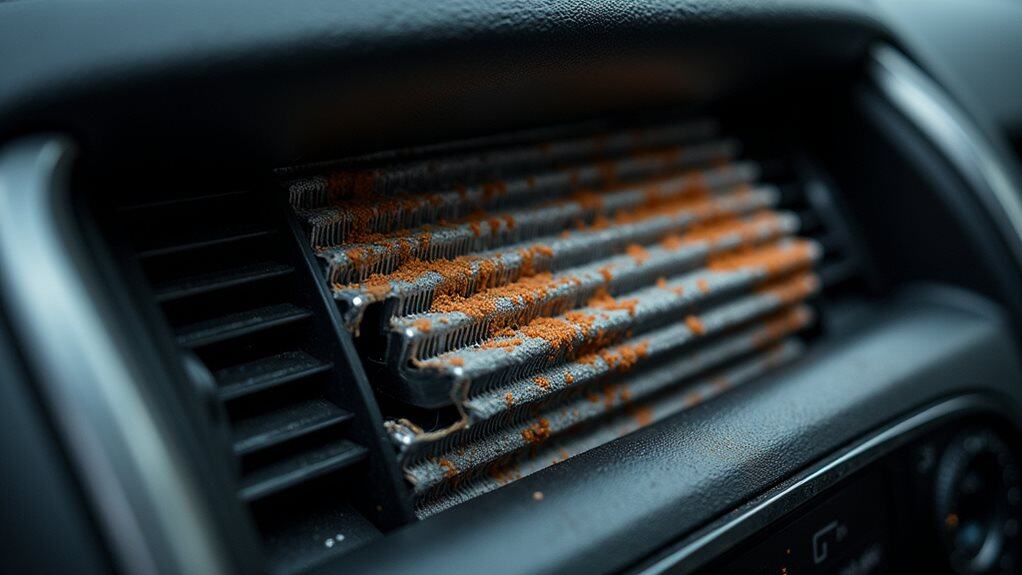Your Ford Edge’s AC blows hot air primarily due to low refrigerant levels from leaks, faulty blend door actuators that can’t mix temperatures properly, or blown fuses disabling the compressor. You’ll need to check system pressure readings, inspect electrical connections, and verify the cabin air filter isn’t clogged. Common leak sources include damaged hoses and deteriorated seals, while warm air from vents confirms refrigerant loss. Understanding these diagnostic steps helps you tackle more complex repair procedures effectively.
Quick Tips
- Check refrigerant levels first, as low levels from leaks are the most common cause of hot air output.
- Test blend door actuators which control air temperature mixing and frequently malfunction in Ford Edge models.
- Inspect electrical connections and fuses, particularly the compressor clutch circuit that enables cooling operation.
- Examine the expansion valve for clogs that restrict refrigerant flow to the evaporator core.
- Verify proper system pressure readings and recharge refrigerant only when ambient temperature exceeds 55°F.
Common Causes of Hot Air Output in Ford Edge AC Systems

When your Ford Edge starts blowing hot air instead of cool, invigorating air conditioning, several underlying issues could be disrupting your vehicle’s cooling system.
Low refrigerant levels from leaks prevent effective heat absorption. Malfunctioning blend door actuators can’t properly mix air temperatures. Blown fuses disable compressor operation, while faulty electrical connections disrupt climate control signals. Additionally, low refrigerant levels can lead to increased compressor cycling, further exacerbating the problem.
A stuck actuator may require multiple reset attempts to restore proper functionality and temperature control.
Dirty Cabin Air Filter Impact on Cooling Performance
Beyond these mechanical and electrical failures, a surprisingly simple component can greatly compromise your Ford Edge’s air conditioning performance: the cabin air filter.
When clogged with dust, pollen, and debris, this filter restricts airflow through your HVAC system. Cooling efficiency can be significantly impacted by restricted airflow, forcing your AC to work harder, decreasing cooling efficiency, and causing noticeably weaker air output from vents. A clogged filter can also produce musty smells inside your vehicle, indicating it’s time for replacement.
Refrigerant Leaks and Low System Pressure Diagnosis

Although dirty cabin air filters can reduce cooling efficiency, refrigerant leaks represent a more serious threat to your Ford Edge’s AC system performance.
These leaks typically originate from damaged hoses, deteriorated seals, or loose connections. You’ll notice warm air blowing from vents, especially while idling, and low system pressure readings on manifold gauges confirm refrigerant loss. Additionally, insufficient brake fluid can lead to issues with other vehicle systems that may indirectly affect AC performance.
Electrical Component Troubleshooting for AC Problems
While refrigerant leaks pose mechanical challenges to your Ford Edge’s AC system, electrical component failures can create equally frustrating cooling problems that often prove more complex to diagnose.
Your HVAC control module governs temperature regulation and blower speed—when it malfunctions, hot air results.
Faulty blend door actuators, weak blower motors, and failed compressor clutch circuits all disrupt cooling performance. Additionally, malfunctioning transmission control module issues can affect overall vehicle functionality, potentially impacting the AC system’s performance as well.
Fuse and Relay Testing for AC System Function

When your Ford Edge’s AC system suddenly stops producing cold air, the culprit often lies within two small but critical electrical components: the AC clutch fuse and relay.
You’ll find both components in the main fuse box under your hood.
Fuse #22 controls the AC clutch solenoid, while relay #33 manages the compressor clutch engagement that’s essential for cooling.
Clogged Expansion Valve and Refrigerant Flow Issues
If your Ford Edge’s AC system produces warm air despite having good fuses and relays, the expansion valve may be restricting refrigerant flow to your evaporator core.
This component converts high-pressure liquid refrigerant into low-pressure cold liquid.
When it’s clogged or stuck, you’ll notice warm air, frost buildup, or frozen evaporator coils requiring professional diagnosis.
Faulty Compressor and Mechanical Component Failures

When your Ford Edge’s AC compressor fails, you’ll notice specific warning signs that indicate serious mechanical problems requiring immediate attention.
Compressor seizure occurs when internal components lock up due to lack of lubrication or mechanical wear, causing the engine to struggle and potentially stall when the AC engages.
Belt and pulley issues often accompany compressor problems, as a seized compressor can cause the drive belt to slip, squeal, or break entirely, while worn pulleys create misalignment that accelerates component failure.
Compressor Seizure Signs
A seized compressor represents one of the most serious mechanical failures in your Ford Edge’s AC system, often resulting from a cascade of internal component breakdowns that render the entire unit inoperable.
You’ll notice the compressor won’t spin freely when the system’s off, indicating internal mechanical locking that prevents normal operation and requires immediate replacement.
Belt and Pulley Issues
While your Ford Edge’s AC compressor gets most of the attention during cooling problems, the belt and pulley system that drives it often becomes the silent culprit behind poor performance.
A loose or worn belt can’t transfer engine power effectively, causing intermittent compressor engagement and warm air from vents.
Squealing noises typically indicate belt slippage requiring immediate replacement.
Condenser Problems and Heat Dissipation Issues
If your Ford Edge’s AC system blows hot air instead of cold, the condenser might be failing to dissipate heat properly.
This component converts high-pressure refrigerant gas into liquid by releasing heat to outside air. When dirt, debris, or damaged fins block airflow, heat dissipation decreases considerably.
Check for physical damage, clean accumulated grime, and verify condenser fans operate correctly.
Dual Climate Control System Malfunctions

When your Ford Edge’s dual climate control system malfunctions, you’ll typically notice distinct temperature differences between the driver and passenger sides of the vehicle.
This occurs when blend door actuators fail, causing one side to blow hot air while the other remains cold. Each climate zone has its own actuator, and individual failure creates uneven heating or cooling throughout the cabin.
Blend Door Actuator and Temperature Control Sensor Problems
The root cause of dual climate control malfunctions often lies within the blend door actuator system, where small electric motors control pivoting doors that direct airflow through your Ford Edge’s heater core or around it.
When these actuators fail, you’ll hear clicking noises from behind the dashboard, and temperature control becomes inconsistent or completely ineffective.
Refrigerant Recharging and Leak Repair Procedures

When your Ford Edge’s AC isn’t cooling properly, you’ll need to check for refrigerant leaks and potentially recharge the system to restore peak performance.
You can detect leaks by inspecting hoses and connections for visible damage, or by using UV dye with a UV light to identify less obvious leak points throughout the system.
Once you’ve addressed any leaks, you’ll follow specific recharging steps that involve connecting to the low pressure port and carefully monitoring pressure levels while adding the correct refrigerant type for your vehicle’s model year.
Leak Detection Methods
Before attempting any refrigerant recharging on your Ford Edge, you must first identify and locate all existing leaks in the AC system.
Use visual inspection to check components for oily residue or stains.
Electronic leak detectors pinpoint exact locations through sensor alerts.
UV dye methods reveal slow leaks under fluorescent light, while soap bubble testing confirms suspected leak areas.
Recharging System Steps
Five essential steps guarantee successful refrigerant recharging in your Ford Edge’s AC system, but proper preparation makes the difference between a lasting repair and repeated failures.
First, verify ambient temperature exceeds 55°F before starting.
Next, identify your refrigerant type—R134a or R1234YF—using the engine bay sticker.
Then locate the low-pressure port, connect securely, and monitor pressures continuously.
Routine Maintenance and Preventive AC Care
Although many Ford Edge owners wait until their AC system fails completely, establishing a consistent maintenance routine can prevent costly repairs and guarantee reliable cooling performance throughout your vehicle’s lifespan.
You’ll need to inspect refrigerant levels monthly, replace cabin air filters every 12,000 miles, and check your serpentine belt for cracks or fraying annually.
Wrapping Up
You’ve now learned the primary causes behind your Ford Edge’s AC blowing hot air and the diagnostic steps to identify each problem. Start with simple checks like cabin air filters and fuses before moving to complex issues like refrigerant leaks or blend door actuators. Regular maintenance prevents most AC problems, but when repairs are needed, you’ll know whether to tackle them yourself or consult a professional technician.

